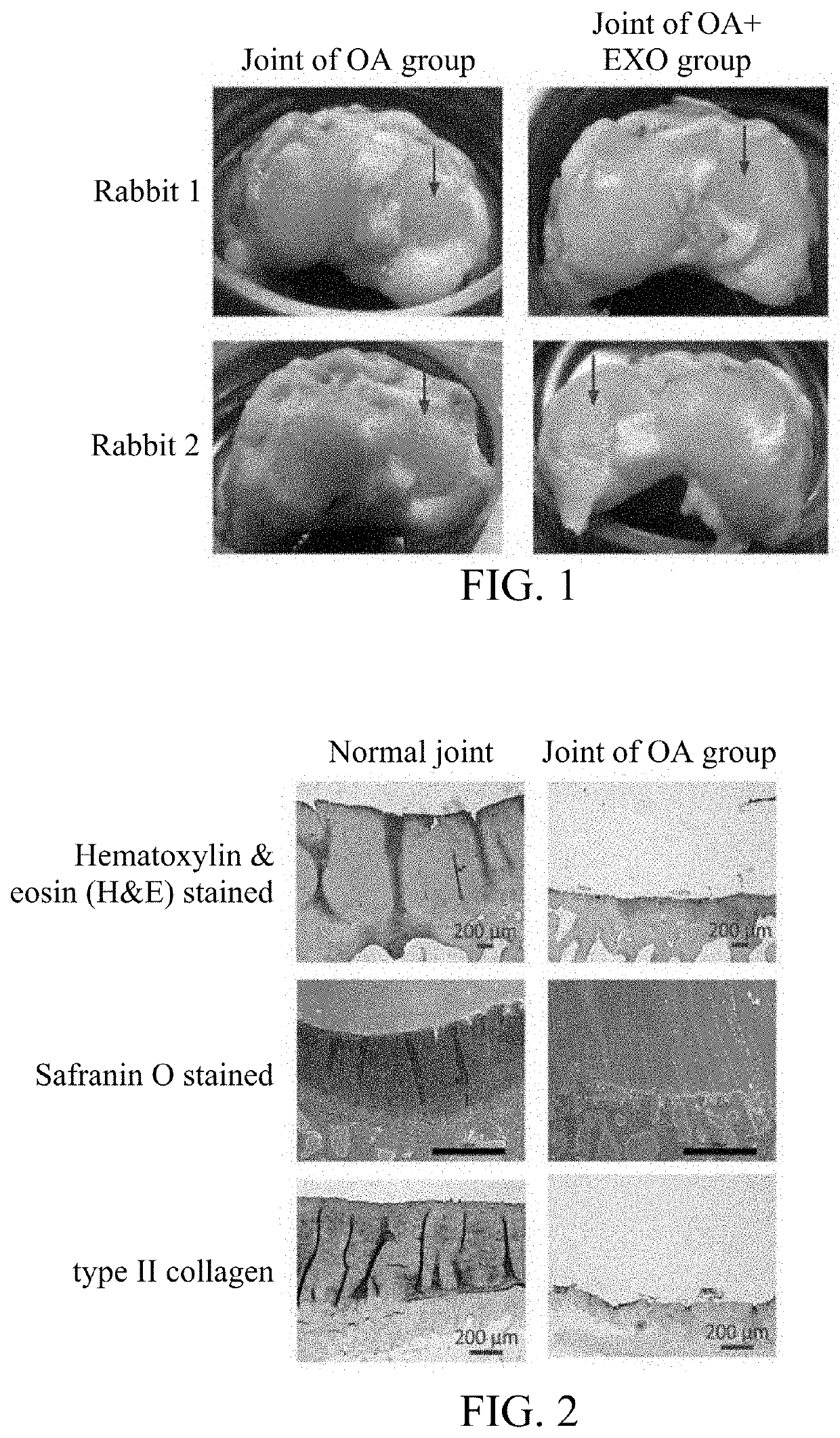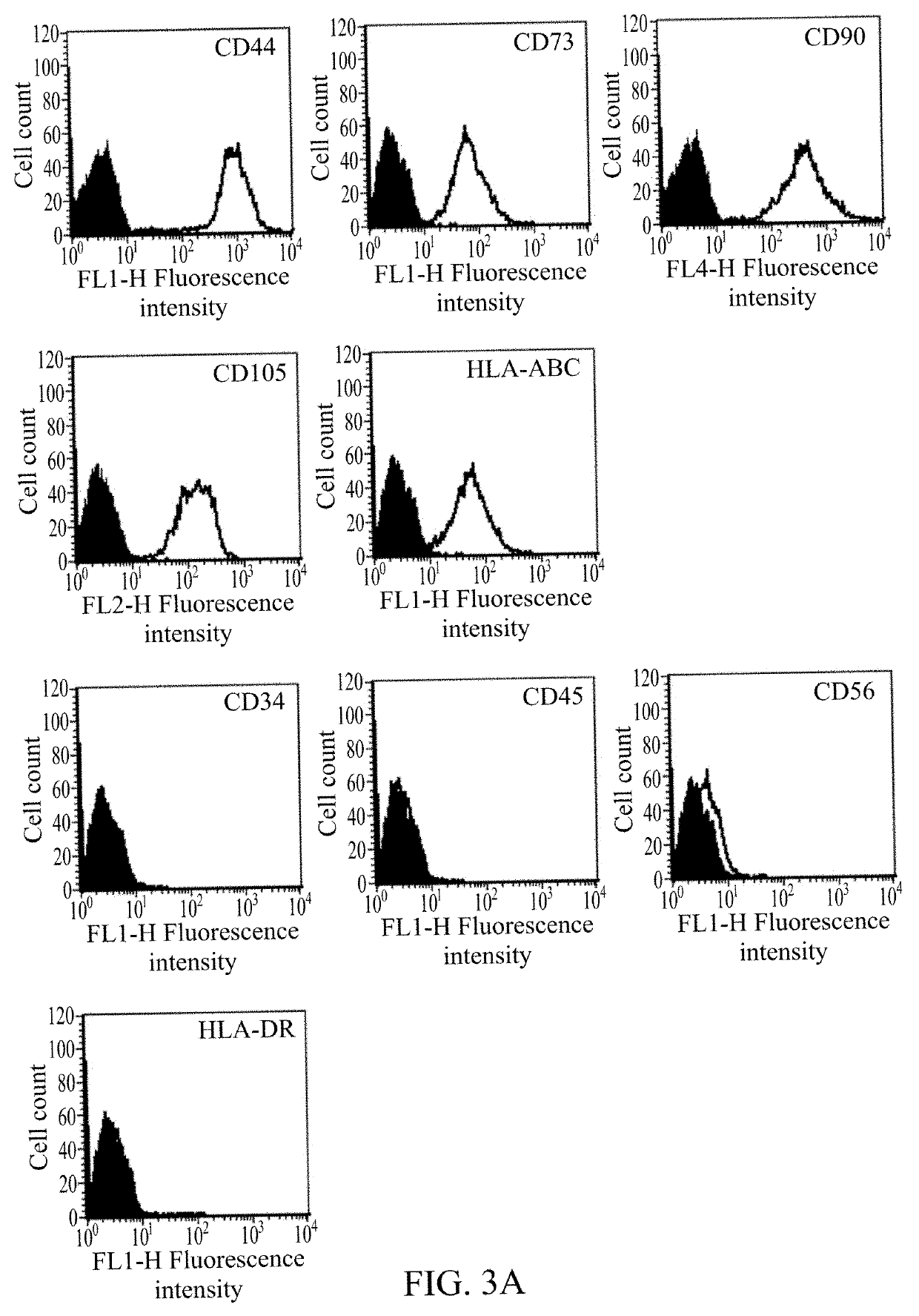Mesenchymal stem cell derived exosomes and method for preventing or treating a joint disorder by administering a composition comprising the same
a technology of mesenchymal stem cells and exosomes, which is applied in the direction of skeletal disorders, medical preparations, unknown materials, etc., can solve the problems of limiting clinical applications of chondrocyte transplantation, limiting clinical applications of osteochondral transplantation, and limiting the clinical application of chondrocyte transplantation. to the human body, and limiting tumorigenicity
- Summary
- Abstract
- Description
- Claims
- Application Information
AI Technical Summary
Benefits of technology
Problems solved by technology
Method used
Image
Examples
example 1
ing an Animal Model
[0031]Twelve 14-month-old New Zealand White (NZW) rabbits were used in this example. Rabbit knee joints were divided into two groups: (1) the OA group: induced osteoarthritis without treatment, n=6; and (2) the experimental group (OA+EXO): induced osteoarthritis with treatment of exosomes, n=6.
[0032]All rabbits were anesthetized by intramuscular injection of ketamine (100 mg / kg) and xylazine (8 mg / kg). Both knees were shaved and disinfected with iodine (Betadine). A medial patella incision was percutaneously made, and arthrotomy was performed to displace patella laterally for the knees to fully flex. Anterior cruciate ligament (ACL) was cut transversely with a 15-gauge blade, and the joint was rinsed with sterile saline before suturing. The joint capsule and synovial membrane were sutured together with 4-0 polypropylene sutures, and the skin was sutured with 3-0 nylon sutures. All rabbits were sent back to the cage after surgery, and allowed to move freely, with a...
example 2
of Human Umbilical Cord Mesenchymal Stem Cells (HUCMSCs)
[0042]The method of obtaining and using human umbilical cord was approved by the Human Test Committee of Buddhist Tzu Chi General Hospital (IRB 100-166). This experimental method was performed according to the Declaration of Helsinki, and was approved by the local ethics review committee. Written informed consents of all subjects were obtained before the experiment. The detailed method for obtaining human umbilical cord mesenchymal stem cells is known in the art, and the specific implementation of this embodiment is as follows.
[0043]Briefly, human umbilical cord specimens (20 cm in length and 20 g in weight) were collected in sterile boxes containing Hankpin's balanced salt solution (Gibco / BRL 14185-052, Grand Island, N.Y., USA), and Wharton's jelly (WJ) was isolated from blood vessels and amnion in 24 hours.
[0044]First, the human umbilical cord was washed for three times with Ca2+ and Mg2+-free phosphate buffered saline (PBS, ...
example 3
istics and Differentiation Capability of Human Umbilical Cord Mesenchymal Stem Cells (HUCMSCs)
[0046]The surface molecular characteristics of human umbilical cord mesenchymal stem cells cultured on passage 3 or 4 were measured by flow cytometry. Cells were detached using Accutase (Millipore, Billerica, Mass., USA) in PBS, and washed with PBS containing 2% fetal bovine serum albumin (Sigma) and 0.1% sodium azide (Sigma). Next, they were incubated with respective antibodies conjugated with fluorescein isothiocyanate or phycoerythrin, including CD29, CD34, CD44, CD45, CD56, CD73, CD90, CD105, HLA-ABC, and HLA-DR (BD PharMingen, Franklin Lakes, N.J., USA), and then were analyzed using a flow cytometer (Becton Dickinson, San Jose, Calif., USA).
[0047]As shown in FIG. 3A, the cell surface markers presented by human umbilical cord mesenchymal stem cells were CD44, CD73, CD90, CD105, and HLA-ABC, while the unpresented cell surface markers were CD34, CD45, CD56, and HLA-DR.
[0048]The capability...
PUM
 Login to View More
Login to View More Abstract
Description
Claims
Application Information
 Login to View More
Login to View More - R&D
- Intellectual Property
- Life Sciences
- Materials
- Tech Scout
- Unparalleled Data Quality
- Higher Quality Content
- 60% Fewer Hallucinations
Browse by: Latest US Patents, China's latest patents, Technical Efficacy Thesaurus, Application Domain, Technology Topic, Popular Technical Reports.
© 2025 PatSnap. All rights reserved.Legal|Privacy policy|Modern Slavery Act Transparency Statement|Sitemap|About US| Contact US: help@patsnap.com



